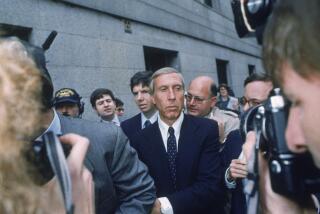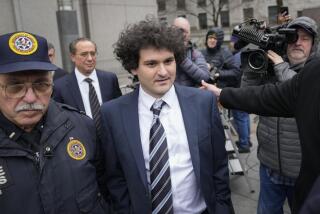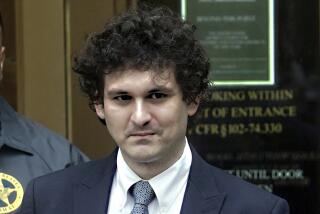Ex-Sotheby’s Chief Found Guilty of Price Fixing
- Share via
NEW YORK — The former chairman of Sotheby’s, A. Alfred Taubman, was found guilty Wednesday of conspiring with rival Christie’s to fix prices in the $4-billion auction industry the two firms have dominated for centuries.
In the sole trial culminating a four-year Justice Department investigation, a federal court jury deliberated little more than a day before convicting Taubman, 76, of plotting with his counterpart at Christie’s to increase the commissions they collected from the sellers of fine art and other goods.
A self-made shopping center developer from Bloomfield Hills, Mich., who bought Sotheby’s in 1983, Taubman faces up to three years in prison at sentencing, scheduled for April 2 by U.S. District Judge George B. Daniels.
Taubman--who is still the largest shareholder in Sotheby’s--sat silently as the verdict was read. He did not testify during the trial, but his own records provided the government with its strongest evidence: his date books listing 12 appointments with a man variously described as “Sir A,” “a gentleman” and “AT.” Prosecutor John J. Greene told the jury those were “secret meetings in secret places” with Sir Anthony Tennant, the chairman of Christie’s.
Attorneys for Taubman argued that there were legitimate reasons for the two men to talk, such as getting the auction houses to stop bad-mouthing each other. But a different explanation was given by the prosecution’s star witness, Diana D. “DeDe” Brooks, the onetime chief executive of Sotheby’s who personally wielded the gavel at Jacqueline Kennedy Onassis’ estate. She had pleaded guilty to a single conspiracy count last year and agreed to testify if prosecutors would ask for leniency when she is sentenced.
Brooks told the jury that the chairmen of the rival houses agreed, in fact, that they “were killing each other on the bottom line, and that it was time to do something about it.”
Taubman then instructed her to work out the details of the price fixing, Brooks said, at her own secret meetings with the chief executive of Christie’s. One of those could have come from a spy movie: Brooks said she picked up Christie’s Christopher M. Davidge at John F. Kennedy International Airport in February 1995 and drove to a parking lot, where they conferred in the back of her Lexus. Davidge disclosed how Christie’s planned to increase its take from sellers’ commissions, she testified, and “I said it looked good to me.”
Christie’s announced its new commissions the next month, Sotheby’s weeks later.
Prosecutors said the two firms increased profits by $400 million through the collusion, not so much by raising their published sellers’ commissions--generally 10%--but by refusing to negotiate it down. Top collectors of Impressionist art or Picassos traditionally had played one against the other to reduce the fee for selling their holdings, sometimes down to nothing. The firms also felt pressure to make contributions to such clients’ favorite charities, or to publish museum-quality catalogs.
The case has had an impact beyond this single trial on an industry that long promoted an image of amiable civility. In the last two years, the four central figures in the trial stepped down from their ruling perches at Sotheby’s and Christie’s; the two firms agreed to pay $512 million in damages to settle a class-action civil suit--with Taubman picking up $172 million of his firm’s share; and a third auction house has tried to win away their elite trade by using the very costly practices Sotheby’s and Christie’s hoped to eliminate.
The free-spending rival, Phillips, de Pury & Luxembourg, has wooed leading collectors by guaranteeing minimum sales prices--agreeing to buy the works itself, in effect, if bidders don’t offer enough.
None of that might have happened if not for a breakthrough in the investigation when it appeared to be stalled. In December 1999, Davidge stepped down as chief executive of the London-based Christie’s and turned over incriminating documents to Justice Department lawyers. In return, he won amnesty from criminal prosecution.
The chairman of Christie’s, Tennant, was eventually indicted along with the two Sotheby’s officials. But he has avoided arrest by staying out of the United States.
In plea bargains in October 2000, Sotheby’s agreed to pay a $45-million criminal fine. And the stage was set for the courtroom showdown of the biggest names in the American auction world when Brooks entered her own guilty plea, saying that she acted “at the direction of a superior.” That meant Taubman, who owned 60% of Sotheby’s stock and was said to have a net worth from $700 million to more than $1 billion.
During her three days on the witness stand, Brooks led a largely working-class jury behind the scenes of auctions, describing how the slumping art prices of the 1990s led Taubman to order the price fixing with their rival. “I was nervous about it, but I agreed to do it willingly,” she said.
Attorneys for Taubman argued that the conspiracy was carried out without his knowledge, by “the two principal witnesses” against him, Brooks and Davidge.
The defense time and again sought to undercut the credibility of Brooks, contending that she was desperate to boost profits to preserve her “celebrity status” and the value of hundreds of thousands of Sotheby’s stock options she held.
“This whole case turns on whether you believe DeDe Brooks beyond a reasonable doubt,” defense attorney Robert B. Fiske Jr. told jurors. “Alfred Taubman is DeDe Brooks’ get-out-of-jail-free card. If that isn’t a powerful motive to lie, I don’t know what is.”
But the prosecution made credibility an issue as well, attacking the defense contention that there were harmless explanations for Taubman’s meeting with the head of Christie’s at his Fifth Avenue apartment and in London.
In his own closing arguments, Justice Department antitrust prosecutor John Greene belittled defense attempts to portray Taubman as a passive chairman who sometimes slept at meetings and was more interested in what was for lunch than in financial statements.
“You don’t become a millionaire, or a billionaire, without being able to read the bottom line,” Fiske said.
The two sides also gave conflicting accounts of a dramatic moment described by Brooks. When investigators closed in, she said, Taubman showed her a copy of London’s Financial Times with her photo on the front page, and said, “You’ll look good in stripes.”
But the defense later called a company lawyer to testify that Taubman actually directed the quip about prison garb at himself, saying, “How’d you think I’d look in stripes?”
On Wednesday, he was in a three-piece gray suit when the jury announced that it had a verdict.
Typical of a trial run with the efficiency of a fast-paced auction--it was completed in less than a month--neither side had much to say afterward. Taubman himself had no comment.
“We were of course disappointed in the verdict,” Fiske said.
More to Read
Inside the business of entertainment
The Wide Shot brings you news, analysis and insights on everything from streaming wars to production — and what it all means for the future.
You may occasionally receive promotional content from the Los Angeles Times.










